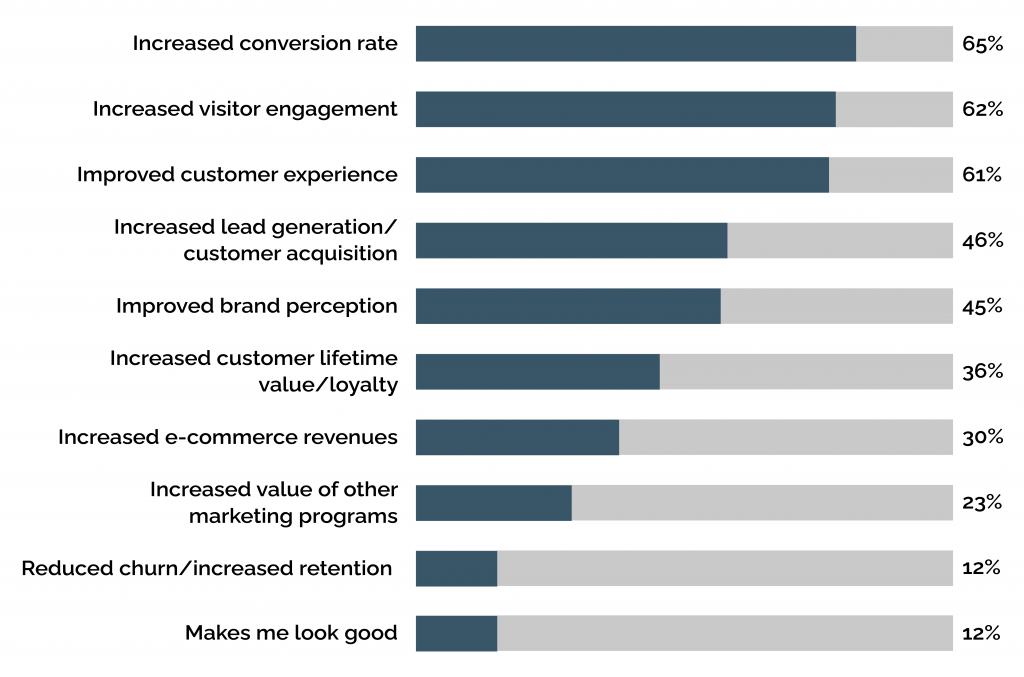Today, a personalized customer experience is at the heart of every business communication strategy and customer experience. This growth mantra helps acquire customers, engage, and retain them in a competitive market.UX designers and researchers are often in the driver’s seat, defining the course of customer interactions and product design. A flexible design that promotes personalization adds so much value and satisfaction to customer-product interactions.
So, what exactly is personalization?
“Personalization is not a trend; it’s a marketing tsunami” – Avi Dan. Personalization is identifying various user types and their needs to deliver relevant content and functionality to them. It focuses on UX enhancement by anticipating and meeting unique user needs that translate to customer conversions.
UX Design and Personalization:
According to Forrester’s research, personalization offers crucial customer centricity and engagement that marketers can leverage. Thus, delivering user experience personalization has become a critical approach for CMOs to attract and convert potential customers.UX personalization helps anticipate and tailor customer journeys and experiences based on varied customer needs, contexts, and preferences instead of making them irrelevant and one-size-fits-all. This article delineates the importance of UX Personalization for designers and how it can add value to end-users.
Why Personalization?
Channelize Information and Reduce Overload: Personalization helps customers focus more on your offerings than on the excessive information flooding their pages. It reduces the amount of info and the options by guiding users through a customized funnel designed for them and their individual needs.
Helps Build Brand Affinity: Personalizing provides innovative customer interactions to strengthen their brand trust and loyalty. This is useful in planning effective UX design strategies across marketing and sales channels. UX Personalization also increases the Customer Lifetime Value when customers resonate with your brand. Studies show that 15% of a brand’s loyal customers account for up to 70% of sales, and not personalizing can kill a significant opportunity to make your customers feel appreciated.
Increases Conversions: With personalization, users get better, more relevant, and individualized experiences. This ultimately translates into increased conversion rates through improved KPIs like page views, hit rates, interactions per session, etc. According to Evergage, 74% of marketers believe that personalization increases customer engagement.
Increases Lead Generation: Personalization increases users’ chances to read and engage in a message, then perform the intended action. Leads relay to your product if you personalize a design by understanding each user’s pain points.
Cross-Selling & Upselling: UX design personalization provides the ability to segregate customer segments and understand them better. Marketers can then plan the type of offers, design, and content they’d like to cross-sell or upsell to various customers (existing or new).
Increases User Engagement: Personalization creates a profound connection between a user and a brand through effective engagement. Also, when users find a personalized product, it reinforces a sense of identity, uniqueness, and relevance to increase preference and usage.
In summary, UX design Personalization is beneficial in the following ways, according to
 How to Start Personalizing UX?
How to Start Personalizing UX?
Begin by defining your strategy and the why, who, where and what of personalizing an experience.
“Why” defines the reason for personalizing UX design to achieve
- Increased conversions or decreased bounce/drop-off rates.
- Improved user engagement.
- More lead generation.
- Increased customer retention.
Answering “Why” will outline the high-level and specific goals of UX personalization.
“Who” defines the target groups you want to cater to differently and meaningfully. These may include:
- Prospects and customers.
- First-time users.
- Users from different demographics or locations.
UX designers should define and map the differences between various users precisely based on their brand, category, interaction, and price preferences.
“Where” defines the areas in your design or the customer channels where you want to introduce personalization. These may include:
- Websites
- Mobile apps
- Emails
- Ads
Any channel where regular customer interactions take place qualifies for different levels of personalization. At this point, mapping the personalized customer journeys coherently and consistently for each target user comes in handy. To know exactly how, please read this article we wrote on customer journey mapping.
“What” defines the message you want to convey to each user group or the intent of UX personalization within the identified channels to achieve a defined goal or deliver a specific experience. This may include:
- Recommendations.
- Indicate different value proposition headlines based on geolocation.
- Navigation or search results’ personalization.
- Promotional messages to specific geolocations, user roles, or interest groups.
When it comes to personalization, adding value to the visitor’s experience is paramount. Providing potential customers with a better sense and understanding of your brand (through UX design) will make them feel comfortable with your brand while improving conversions.
Recommended Personalization Methods
Having rolled out many customer-centric UX designs successfully, Radiant Digital recommends the following personalization methods to UX designers.
Navigational Personalization: This method builds on a customer’s browsing behavior and purchase history. You can customize how you want the user to navigate your website. For example, you could highlight a previous purchase for the customer on an eCommerce website to repeat the order or display a pop-up page for discounts and offers before the home page is displayed. This will increase the chances of a user clicking and performing a positive action on the website.
Predictive Recommendation: Recommendation engines can accurately analyze relevant buying behavior from similar users and recommend products or actions that a person might be interested in. This method is helpful for email campaigns, e-commerce sites, or transactional apps. For example, this method has been beneficial for Amazon, where 30% of their sales are generated via predictive recommendations.
Contextual Messaging: Using this personalization method, you can personalize messages for users based on their location, behavior, or device type. This helps design apps and deliver content more relevantly, which adds value to the customer interaction. For example, Amazon uses geolocation messaging to display if a user can ship the item to their location, along with the estimated delivery time.
Will Common Designs Work Hereafter?
Based on the following factors, the UX design should change and serve the user’s intent.
- Geolocation
- Traffic source
- The browser or device type
- Number of site visits, logins, pages/screens viewed
- Active time spent
- The time of the last visit, email read, etc.
- Purchases made, articles read, videos viewed, etc.
- Mouse movement (scrolling, hovering, inactivity)
Standard designs will slowly fade soon, while competitive applications will use personalization to engage more customers through their interests and preferences to shape user-centric and design-led UX. Machines Learning will intelligently understand the story behind the user’s interactions to adapt to contextual factors continuously. This will allow companies to implement real-time personalization in their designs.
Wrapping up
Who doesn’t say ‘Yes’ to a personalized experience? Businesses can succeed in today’s digital era by planning and aligning their customer empathy and UX enrichment strategies.
Want to connect better with your customers through personalized and empowering designs? Radiant Digital can help you get there. Call us today!


